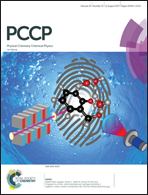Explicit consideration of spatial hydrogen bonding direction for activity coefficient prediction based on implicit solvation calculations†
Abstract
The activity coefficient of a chemical in a mixture is important in understanding the thermodynamic properties and non-ideality of the mixture. The COSMO-SAC model based on the result of quantum mechanical implicit solvation calculations has been shown to provide reliable predictions of activity coefficients for mixed fluids. However, it is found that the prediction accuracy is in general inferior for associating fluids. Existing methods for describing the hydrogen-bonding interaction consider the strength of the interaction based only on the polarity of the screening charges, neglecting the fact that the formation of hydrogen bonds requires a specific orientation between the donor and acceptor pairs. In this work, we propose a new approach that takes into account the spatial orientational constraints in hydrogen bonds. Based on the Valence Shell Electron Pair Repulsion (VSEPR) theory, the molecular surfaces associated with the formation of hydrogen bonds are limited to those in the projection of the lone pair electrons of hydrogen bond acceptors, in addition to the polarity of the surface screening charges. Our results show that this new directional hydrogen bond approach, denoted as the COSMO-SAC(DHB) model, requires fewer universal parameters and is significantly more accurate and reliable compared to previous models for a variety of properties, including vapor–liquid equilibria (VLE), infinite dilution activity coefficient (IDAC) and water-octanol partition coefficient (Kow).



 Please wait while we load your content...
Please wait while we load your content...